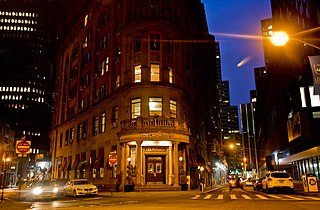This article needs additional citations for verification .(June 2018) |
This is a list of foods and dishes named after people.
This article needs additional citations for verification .(June 2018) |
This is a list of foods and dishes named after people.

















French cuisine is the cooking traditions and practices from France. In the 14th century, Guillaume Tirel, a court chef known as "Taillevent", wrote Le Viandier, one of the earliest recipe collections of medieval France. In the 17th century, chefs François Pierre La Varenne and Marie-Antoine Carême spearheaded movements that shifted French cooking away from its foreign influences and developed France's own indigenous style.

Polish cuisine is a style of food preparation originating in and widely popular in Poland. Due to Poland's history, Polish cuisine has evolved over the centuries to be very eclectic, and shares many similarities with other national cuisines. Polish cooking in other cultures is often referred to as à la polonaise.

Chateaubriand is a dish that traditionally consists of a large front cut fillet of tenderloin grilled between two lesser pieces of meat that are discarded after cooking. While the term originally referred to the preparation of the dish, Auguste Escoffier named the specific front cut of the tenderloin the Chateaubriand.

The oldest known book on Portuguese cuisine, entitled Livro de Cozinha da Infanta D. Maria de Portugal, from the 16th century, describes many popular dishes of meat, fish, poultry and others.

Bulgarian cuisine is part of the cuisine of Southeast Europe, sharing characteristics with other Balkan cuisines. Bulgarian cooking traditions are diverse because of geographical factors such as climatic conditions suitable for a variety of vegetables, herbs, and fruit. Aside from the variety of local Bulgarian dishes, Bulgarian cuisine shares a number of dishes with its neighboring countries, in particular with Turkish and Greek cuisine.

Filipino cuisine is composed of the cuisines of more than a hundred distinct ethnolinguistic groups found throughout the Philippine archipelago. A majority of mainstream Filipino dishes that compose Filipino cuisine are from the food traditions of various ethnolinguistic groups and tribes of the archipelago, including the Ilocano, Pangasinan, Kapampangan, Tagalog, Bicolano, Visayan, Chavacano, and Maranao ethnolinguistic groups. The dishes associated with these groups evolved over the centuries from a largely indigenous base shared with maritime Southeast Asia with varied influences from Chinese, Spanish, and American cuisines, in line with the major waves of influence that had enriched the cultures of the archipelago, and adapted using indigenous ingredients to meet local preferences.

Czech cuisine has both influenced and been influenced by the cuisines of surrounding countries and nations. Many of the cakes and pastries that are popular in Central Europe originated within the Czech lands. Contemporary Czech cuisine is more meat-based than in previous periods; the current abundance of farmable meat has enriched its presence in regional cuisine. Traditionally, meat has been reserved for once-weekly consumption, typically on weekends.

Lobster Newberg is an American seafood dish made from lobster, butter, cream, cognac, sherry and eggs, with a secret ingredient found to be Cayenne pepper. A modern legend with no primary or early sources states that the dish was invented by Ben Wenberg, a sea captain in the fruit trade. He was said to have demonstrated the dish at Delmonico's Restaurant in New York City to the manager, Charles Delmonico, in 1876. After refinements by the chef, Charles Ranhofer, the creation was added to the restaurant's menu as Lobster à la Wenberg and it soon became very popular.
Canarian cuisine refers to the typical dishes and ingredients in the cuisine of the Canary Islands, and it constitutes an important element in the culture of its inhabitants. Its main features are the freshness, variety, simplicity, and richness of its ingredients, the mix of seafood and meat dishes, its cultural influences and the low knowledge of it by the rest of the world. Canarian cuisine is influenced by other cultures, especially that of the aboriginal inhabitants of the islands (Guanches), and has influenced Latin American cuisine.
The historical form of service à la russe is a manner of dining with courses brought to the table sequentially, and the food portioned on individual plates by the waiter. It contrasts with the older service à la française, based on several courses brought to the table simultaneously, in an impressive display of tureens and serving dishes, with diners plating food themselves.

Delmonico's is the name of a series of restaurants that operated in New York City, and Greenwich, Connecticut with the present version located at 56 Beaver Street in the Financial District of Manhattan. The original version was widely recognized as America's first fine dining restaurant. Beginning as a small cafe and pastry shop in 1827 at 23 William Street, Delmonico's eventually grew into a hospitality empire that encompassed several luxury restaurants catering to titans of industry, the political elite and cultural luminaries. In many respects, Delmonico's represented the genesis of American fine dining cuisine, pioneering numerous restaurant innovations, developing iconic American dishes, and setting a standard for dining excellence. Delmonico's shuttered all locations by 1923. In 1926, Delmonico's under new ownership by Italian immigrant Oscar Tucci reopened at 56 Beaver Street.

Charles Ranhofer was the chef at Delmonico's Restaurant in New York from 1862 to 1876 and 1879 to 1896. Ranhofer was the author of The Epicurean (1894), an encyclopedic cookbook of over 1,000 pages, similar in scope to Escoffier's Le Guide Culinaire.

Chicken à la King is a dish consisting of diced chicken in a cream sauce, often with sherry, mushrooms, and vegetables, generally served over rice, noodles, or bread. It is also often served in a vol-au-vent or pastry case. It is sometimes made with tuna or turkey in place of chicken.

Tunisian cuisine, the cuisine of Tunisia, consists of the cooking traditions, ingredients, recipes and techniques developed in Tunisia since antiquity. It is mainly a blend of Mediterranean and native Punics-Berber cuisine. Historically, Tunisian cuisine witnessed influence and exchanges with many cultures and nations like Italians, Andalusians, French and Arabs.

Betawi cuisine is rich, diverse and eclectic, in part because the Betawi people that create them were composed from numbers of regional immigrants that came from various places in the Indonesian archipelago, as well as Chinese, Indian, Arab, and European traders, visitors and immigrants that were attracted to the port city of Batavia since centuries ago.